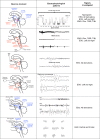Neurophysiological basis of rapid eye movement sleep behavior disorder: informing future drug development
- PMID: 27186147
- PMCID: PMC4847600
- DOI: 10.2147/NSS.S99240
Neurophysiological basis of rapid eye movement sleep behavior disorder: informing future drug development
Abstract
Rapid eye movement (REM) sleep behavior disorder (RBD) is a parasomnia characterized by a history of recurrent nocturnal dream enactment behavior and loss of skeletal muscle atonia and increased phasic muscle activity during REM sleep: REM sleep without atonia. RBD and associated comorbidities have recently been identified as one of the most specific and potentially sensitive risk factors for later development of any of the alpha-synucleinopathies: Parkinson's disease, dementia with Lewy bodies, and other atypical parkinsonian syndromes. Several other sleep-related abnormalities have recently been identified in patients with RBD/Parkinson's disease who experience abnormalities in sleep electroencephalographic frequencies, sleep-wake transitions, wake and sleep stability, occurrence and morphology of sleep spindles, and electrooculography measures. These findings suggest a gradual involvement of the brainstem and other structures, which is in line with the gradual involvement known in these disorders. We propose that these findings may help identify biomarkers of individuals at high risk of subsequent conversion to parkinsonism.
Keywords: brain stem; hypocretin; hypothalamus; motor control.
Figures

References
-
- Jouvet M. Paradoxical sleep – a study of its nature and mechanisms. Prog Brain Res. 1965;18:20–62. - PubMed
-
- Schenck CH, Bundlie SR, Ettinger MG, Mahowald MW. Chronic behavioral disorders of human REM sleep: a new category of parasomnia. Sleep. 1986;9:293–308. - PubMed
-
- Schenck CH, Montplaisir JY, Frauscher B, et al. Rapid eye movement sleep behavior disorder: devising controlled active treatment studies for symptomatic and neuroprotective therapy – a consensus statement from the International Rapid Eye Movement Sleep Behavior Disorder Study Group. Sleep Med. 2013;14:795–806. - PMC - PubMed
-
- Sforza E, Zucconi M, Petronelli R, Lugaresi E, Cirignotta F. REM sleep behavioral disorders. Eur Neurol. 1988;28:295–300. - PubMed
Publication types
LinkOut - more resources
Full Text Sources
Other Literature Sources

